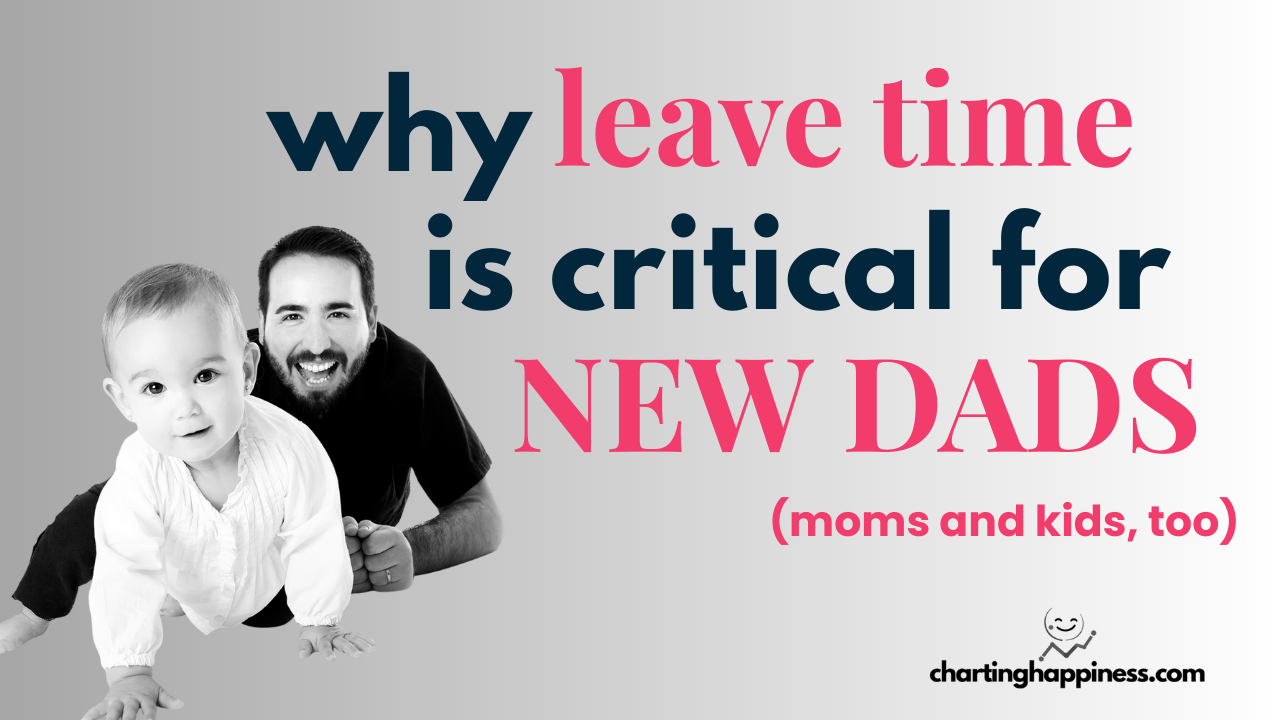Many parents express that the birth of their first child is the happiest moment of their lives.
My older brother (child 1) has a thick baby album festooned with decoupage. I (child 2) have a manila envelope with “JC” scribbled in sharpie.
(Therapy’s helping.)
But there’s also evidence from social science that new dads are less happy than their childless peers.
So which is it? Does becoming a dad bring joy or misery? Or just sleep deprivation?
The lived reality usually depends on how men walk into fatherhood. And this doorway is heavily conditioned by a new dad’s access to paternal leave time.
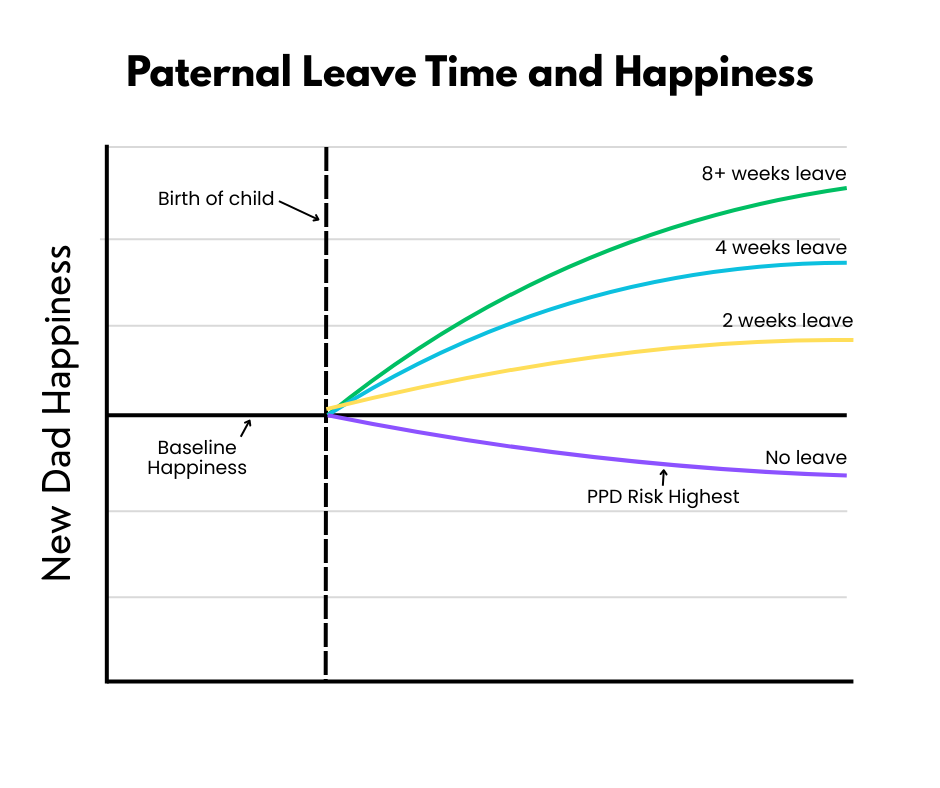
Quick stats: Paternity leave is an underutilized benefit for many men. In the U.S., only 36% of dads take more than two weeks leave. The rest take less or, sadly, none at all. Less than 5% take more than two weeks.
Whether you’re expecting babies or done making ‘em, cozy up to this one. I’m about to explain why leave time keeps new dads from putting their baby into a donation box.
It’s on all of us to prevent that—or, at minimum, to tell them to poke some holes in the top.
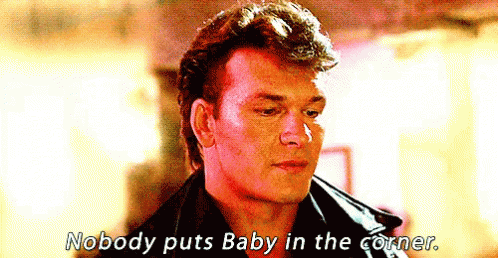
Paternity leave and Post-Partum Depression (PPD)
One aspect of this is post-partum depression (PPD), which does affect men. The numbers are all over the place, but somewhere between 10 and 20% of new dads get the baby blues. (Sorry to steal your thunder, ladies.)
Notably, if their partner is experiencing PPD, the number can jump to 50 percent. (What’s that saying about a happy wife?)

Taking at least 2 weeks of leave time reduces a new dad’s risk of PPD by up to 26%. There’s also a dose effect, meaning the more leave time (3+ weeks) the more benefit we see.
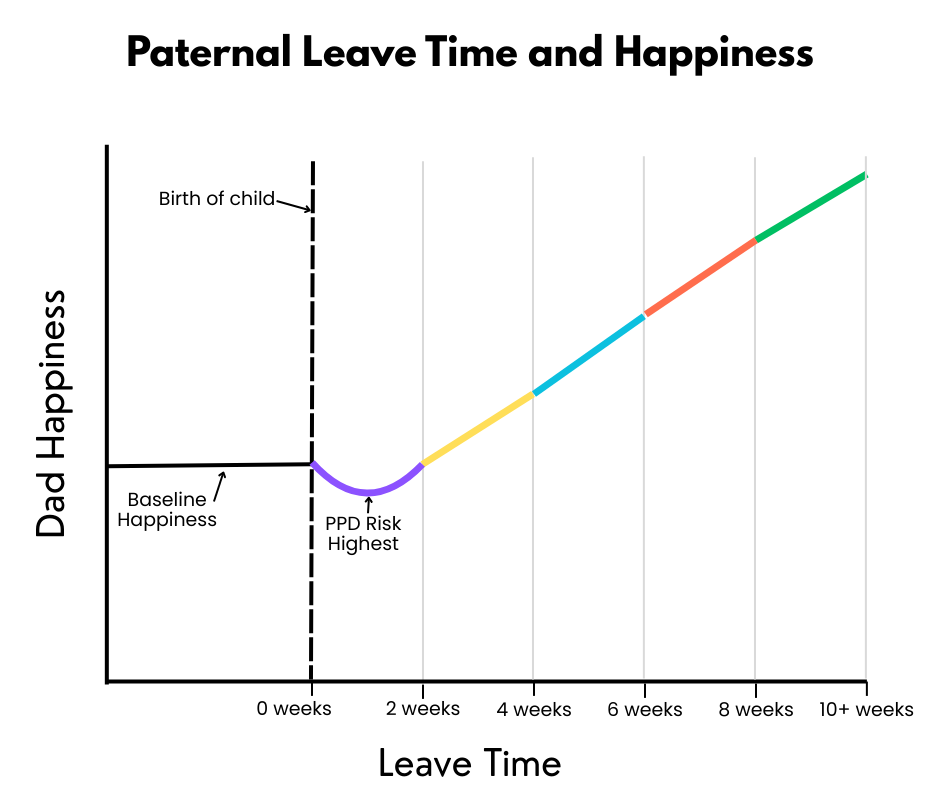
specific data.
Side note: According to one meta-analysis, screening methods heavily influence PPD diagnosis rates for men. Self-rating methods led to higher incidences (17%) versus interviews (4%). Two potential explanations: 1) Men are hesitant to openly discuss their depression in an interview; 2) Interviewer bias. They don’t expect men to have PPD so they don’t see it. Message me to let me know what you think.
FWIW, PPD for dads typically surfaces about 3-6 months into fatherhood, which is later than for moms. There are a few possible reasons:
- Women experience hormonal shifts immediately after child birth. Male hormonal changes are slower and gradual. These include declining testosterone and fluctuating levels of estrogen, cortisol, and vasopressin.
- The dad role often means bearing less of the parenting burden than moms. (Every breastfeeding mom just yelled, “ya think?!?!”) But over time, stressors like work-life balance and sleep deprivation can mount.
- Psychologically adapting to fatherhood unfolds more slowly for men. Importantly, many new dads feel emotionally disconnected in the initial weeks and months of fatherhood. Mom and baby are uniquely connected and they’re the odd person out. This can settle in slowly over time.
Leave time helps with most (maybe all) of these. And a quick review of this list shows why the dose effect shows up in the relationship between leave time and happiness for dads.
More opportunities to bond.
More time for sleep.
Enhanced work-life balance.
A window to call the doctor and say, Me want testosterone. Me want be strong man.

Leave time and Family Dynamics
How we experience our home life will ultimately shape life satisfaction. There’s no other environment more important than the home.
So it’s worth asking, how does a new dad’s leave time affect family dynamics and relationships?
First, there’s a connection between family-friendly leave policies and increased life satisfaction. This is the case for both fathers and mothers.
There’s also a link between more egalitarian leave policies and better relationships at home, including lower conflict and higher marital satisfaction. This is called a “spillover effect”: One thing (leave time) cascades into other parts of life (relationships).
I’ve written elsewhere about marriage and happiness. It’s no secret that there’s often a spike in marital satisfaction right after a baby is born. But that quickly turns into a dip in satisfaction when the weight of parenting settles in. Leave time is an anchor that can keep you on solid ground.
Side note: This is probably why cross-national studies have found a societal effect, where family-friendly laws lead to better happiness outcomes. It also explains why Americans are more likely to be less happy after becoming parents.
Paternal leave time has lasting effects on father-child bonding. Here’s why: When dads get baby time, they become more confident and involved. The quality of these interactions build a connection for years to come, compounding over time.
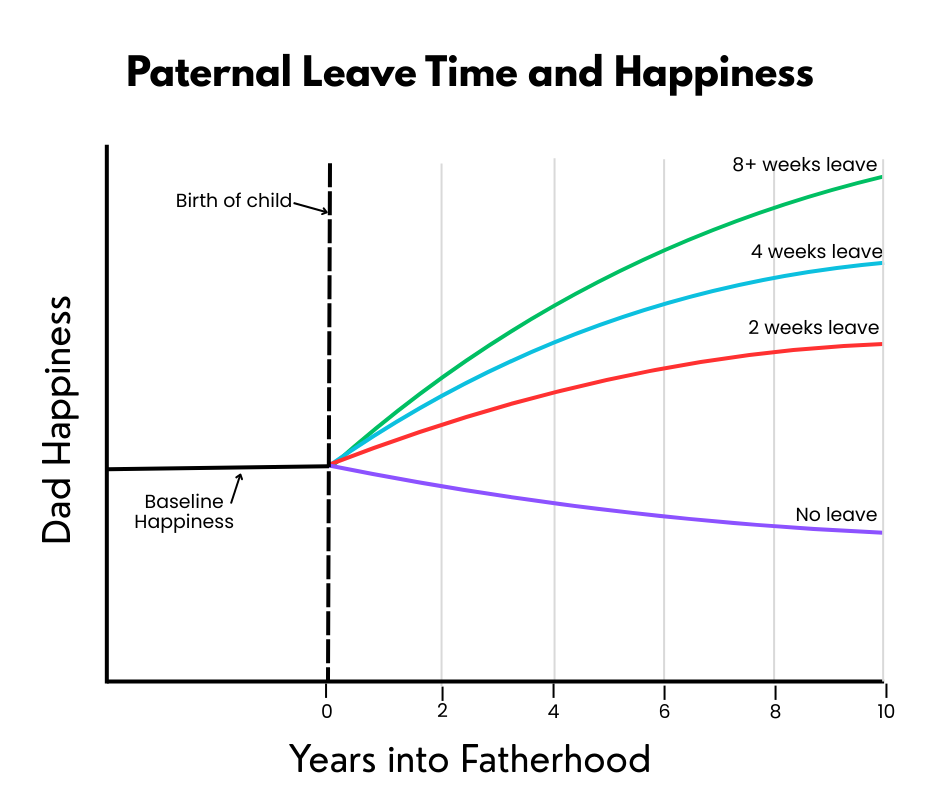
One study asked 9-year olds to grade their relationship with their dad. Leave time was a strong predictor of how they felt a decade into their lives. When dads took more than 2 weeks leave it led to healthier father-child relationships.
When asked if their dads were “cool”, the child participants became giddy with laughter. (The study didn’t actually cover this, but I’m sure it’s true.)
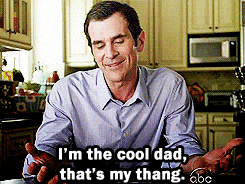
Finally, I want to go back to the spillover effect I mentioned above.
Data from Princeton’s Fragile Families and Child Wellbeing study found that paternal leave time influences parental relationship quality and coparenting. This effect was still there 5 years later. The authors noted that it was a spillover from dads being more involved in family life.
It’s not just child bonds, but also partner bonds that benefit from extended leave time.
Does Paternal Leave Improve Work Life?
There is an impact on work life, although the data is mixed.
One meta-analysis found there was little to no effect on job satisfaction. They concluded that “the increase in life satisfaction does not seem to come from changes in the work environment, but rather changes in the home environment.”
And yet, other studies point to an indirect (but significant) effect of leave policies on productivity, satisfaction, and loyalty.
It’s possible that the work part is complicated because it’s a double-edged sword. A McKinsey study noted that 20% of dads feel like their career (promotion) was negatively impacted by taking extended leave.
That same 20% of dads also reported their boss was a heartless dickhead. (If they didn’t, they should have.)

Despite any brown linings, the study found that, in the end, the vast majority of dads still felt like the time was worth taking. Two stats from Pew explain why: 62% of men found childcare hours to be meaningful, versus 32% who felt the same way about work hours.
Parenting is more meaningful than work. Thus the time feels better spent.
What to do
It’s hard to draw a straight causal line with this data. But it’s equally hard to dismiss how critical leave time is.
Simply put, getting it increases the likelihood of good family outcomes. On the other hand, sadly, not taking leave is connected to lower quality relationships and less happiness.
There are a few things you can do to make sure you’re on the good side of this equation:
- If your baby is on the way, check into your employer’s leave policies and start planning to take advantage of what’s offered. Your worst case scenario is FMLA which guarantees you 12 weeks unpaid leave, by law. Remember that there’s a dose effect. The more leave you take, the better your family life and the happier you’ll be.
- Quantity is important, but quality matters more. Whatever time you get, try to be as actively engaged as you can. Presence is cool. Hands-on is badass. Holding, feeding, soothing, breast pump maintenance, whatever. Communicate to your partner that you want to be involved. They’ll appreciate it and help create opportunities. Then wear those spit-up stained shirts with pride.
- Done making babies? Communicate the value of paternity leave to new or soon-to-be dads. Let them know that both quantity and quality matter. You’re a role model for them, an informal mentor of sorts. Embrace your influence.
- Got older kids? Keep in mind that it’s never too late. What these studies ultimately show is that father involvement matters, whenever it happens. Paternal leave time is just a convenient way to study the issue. Try to snag a flexible work arrangement if you can to get more time. Whatever time you get, use it wisely.
Unless you have a lot of kids, you won’t spend much of your life taking care of babies. And yet, it’s probably the most impactful sliver of time we have. Take leave. Hopefully lots. And dive in.
It’s a big part of building a fulfilling family life which, in turn, heavily impacts overall happiness.

